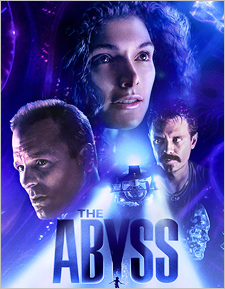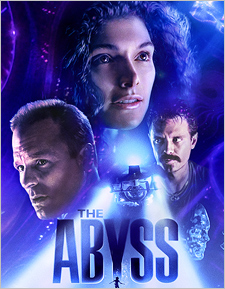Abyss, The (4K Digital Review)

Director
James CameronRelease Date(s)
1989/1993 (December 12, 2023)Studio(s)
20th Century Fox (Studios) (Buena Vista Home Entertainment)- Film/Program Grade: See Below
- Video Grade: A-
- Audio Grade: A
- Extras Grade: N/A
Review
“…when you look long into an abyss, the abyss also looks into you.” –Friedrich Nietzsche
When the ballistic missile submarine USS Montana goes down on the edge of the Cayman Trough after encountering an unusual underwater object, the US Navy recruits the crew of the privately-owned Deepcore underwater drilling platform—led by Bud Brigman (Ed Harris) and his estranged wife Dr. Lindsey Brigman (Mary Elizabeth Mastrantonio)—to effect a rescue. Along for the ride, and technically in command of the mission, is a SEAL team led by Lieutenant Coffey (Michael Biehn). Upon reaching the wreck site, the crew soon discovers that there’s no one left to rescue. But unknown to Deepcore’s crew, the SEALs plan to scuttle the wreck with one of the sub’s own MIRV warheads to prevent the rest of its nukes from falling into Russian hands.
Up on the surface, things are already heating up between the US and Russia. To make matters worse, a hurricane cuts Deepcore off from its support ship, Benthic Explorer. Things start going wrong underwater too, including debris from the support ship’s crane that comes crashing down from the surface to damage their platform, not to mention the fact that Coffey begins showing signs of compression sickness that’s slowly driving him mad (even as he controls the nuclear warhead). As if that wasn’t bad enough, a strange and seemingly unearthly force hidden in the depths of the Trough begins making appearances at the most inopportune moments, causing the pressure on Deepcore’s crew to mount both literally and figuratively.
When James Cameron sets out to make a movie, he really doesn’t screw around. In its day, Cameron’s The Abyss set the standard for underwater filmmaking, essentially shooting “real for real.” The entire set was submerged in 55 feet of water (7.5 million gallons) in a special tank made from the containment building of a half-completed and abandoned nuclear reactor. Special diving equipment was designed specifically for the production, including hard-hat diving suits and real submersibles. What’s more, the entire cast and crew was trained to work underwater. Large 1/4 scale sub miniatures were actually shot underwater, while 1/10 scale surface vessel miniatures were filmed practically in an actual gale on the open ocean. And of course the infamous “pseudopod” scene pushed Dennis Muren’s team at Industrial Light and Magic to create the first ever soft-surface CGI character in film. All of this gives The Abyss a thrilling “you-are-there” atmosphere, and an exceptional and seldom-achieved level of cinematic realism. That look of fear you see in the actors’ eyes is often real, the on-set danger ever present. Add to that some terrific acting by Harris, Mastrantonio, and Biehn, and you’ve got a fine and genuinely unique underwater thriller.
In addition to the 140-minute Theatrical Version, Cameron completed a 171-minute Special Edition in 1993 that is a significantly better experience. Whereas the Theatrical Version grinds to a bewildering and unearned conclusion, the Special Edition’s restored scenes add depth to the characters’ backstories and a much needed measure of tension in the form of newscasts that reinforce the superpower political drama unfolding on the surface. All of that leads to a longer and much more satisfying ending, which now has both a point and a moral. That isn’t quite enough to make The Abyss a truly great film, but it definitely gives the ride some badly needed payoff. And the ride itself makes the film worth viewing all on its own.
The Abyss was shot by cinematographer Mikael Salomon (Band of Brothers, Backdraft) on 35 mm photochemical film (in Super-35 “common top” format, with a variety of Eastman EXR stocks, often at 100 ASA) using Arriflex 35 BL3, 35Il, and Clairmont cameras, with Zeiss Standard Speed and Super Speed spherical lenses. Visual effects were also filmed in Super Panavision 70 format, with some plates done in VistaVision. The film was then finished photochemically in the 2.39:1 aspect ratio for theaters (which included 35 mm anamorphic blow-up release prints, as well as 70 mm blow-ups). For its release on Ultra HD, Lightstorm, working with Park Road Post, has built a new 4K Digital Intermediate using recent 4K scans of the original camera negative (confirmed per Lightstorm). This footage was then “optimized” by Park Road’s proprietary deep-learning algorithms. Photochemical grain has been greatly reduced, though not eliminated entirely, while fine detail has been “enhanced” algorithmically. The image has also been graded for high dynamic range, with both Dolby Vision and HDR10 available.
The result is extraordinary clarity and detail, so much so that it’s actually a little jarring. The film looks almost modern now as opposed to vintage late 80s, which is obviously Cameron’s intent. I’ve spent the better part of an afternoon looking at the new 4K Digital presentation on Vudu, Apple TV, and Movies Anywhere, and it represents a remarkable improvement over the previous DVD and LaserDisc image (and the forthcoming physical UHD release should improve upon it). There’s still light photochemical grain visible, as well as plenty of fine image detail. The palette is cool blue and gray, with vibrant colors in emergency lighting and display screens. Some of the special effects footage (shot on large format film) offers even greater clarity. Blacks are very deep and the highlights are bold, which definitely benefits underwater shots and especially submerged lighting. There’s no doubt that this is The Abyss looking better than you’ve ever seen it before, save for one particularly janky-looking miniature shot (a dramatic reveal at the very end of the film) that looks like it’s been sourced from SD. (I’m actually surprised it wasn’t redone with CG, because it’s always looked terrible.) This 4K image certainly isn’t perfect—it occasionally looks a little bit processed. Like Aliens and Titanic in 4K however, the more I look at this image, the more I appreciate it, and I suspect that most fans will feel the same. But the clarity increase is so dramatic that it does take a little bit of getting used to.
The film’s primary English audio is included in a new Dolby Atmos mix that features a bigger and more immersive soundstage than ever before. Subtle atmospherics surround the listener, with pleasing creation of unique sonic environments—critical to this film given how much of it takes place in tight spaces and metal-walled compartments. LFE is firm when necessary (the crane fall is a good example), with full-sounding mid tones. Dialogue is clear and readily discernible at all times. Directional effects and movement are smooth and pleasing—hatches slam, bulkheads groan, bubbles wash up around you, and subs and NTIs cruise and flutter around the listening environment. The height channels are employed subtly for overhead completion, but do get more noticeable occasionally, such as when submersibles pass overhead. Alan Silvestri’s score is subtle and mysterious, with clanging percussion, ethereal electronic tones, and occasional brassy flourishes. It’s presented in excellent fidelity and makes use of the entire soundfield. This is a fantastic sonic upgrade that impresses in ways both little and big.
In terms of special features, each Digital provider seems to offer a different selection of bonus content. If such content is included however, you should get a pair of new retrospective documentaries, including Deep Dive: A Conversation with James Cameron (HD – 32:23) and The Legacy of The Abyss (HD – 24:38), each of which offers a good mix of new and legacy interview material as well as upsampled behind-the-scenes footage. There’s also a selection of legacy content from the previous DVD and LaserDisc release. And while the 1993 Special Edition is typically included here too, only the Theatrical Cut seems to be available in actual 4K with HDR and Dolby Atmos. (Note that this may change with a bit of time, as streaming services upgrade their files.) I’ll cover these extras in more depth in our forthcoming review of the 4K UHD disc release.
An underwater pressure cooker with a dash of Close Encounters of the Third Kind for good measure, James Cameron’s The Abyss—particularly its Special Edition version—is a very good and decidedly unique thriller that first revealed Cameron’s interest in submarines and deep-sea exploration, an interest that would not only lead him to Titanic but to the actual wreckage of the Titanic and eventually the bottom of the Challenger Deep. The Abyss in 4K Digital is a remarkable experience, featuring a striking restoration of the film that should please all but the most picky A/V enthusiasts (and it should look even better on 4K disc in the coming months).
Film Ratings (Special Edition/Theatrical): B+/B-
- Bill Hunt
(You can follow Bill on social media on Twitter and Facebook)

